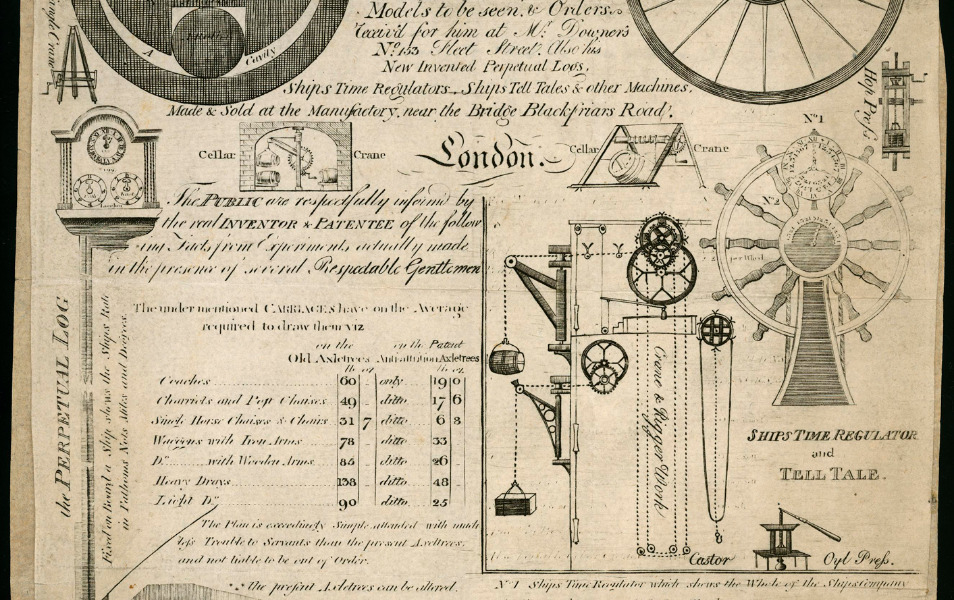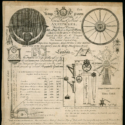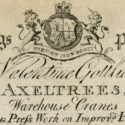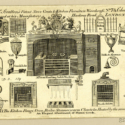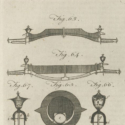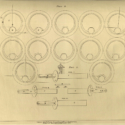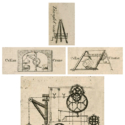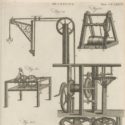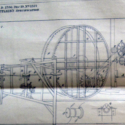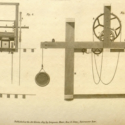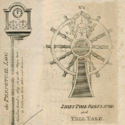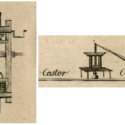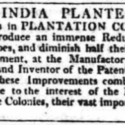Science and the City: Valentine Gottlieb, immigrant engineer of Lambeth: his trade card of c. 1810 unpacked
Article DOI: https://dx.doi.org/10.15180/211510
Abstract
Born in Biebrich, J V Gottlieb was an economic migrant who settled in London in the mid 1770s, initially working as a hairdresser before establishing himself as a mechanical engineer, designing and selling cranes and other machinery. An illustrated trade card in the Science Museum collections provides material evidence of his activities and an opportunity to examine the roles played by such advertising in the development of the technology and commerce of the period. The iconography of this unique item of printed ephemera is used to outline Gottlieb’s various inventive activities. Gottlieb patented his crane designs (1786) and a form of friction-reducing bearing (1787). He successfully lobbied government to install his design of a mechanical perpetual ship’s log to two newly-designed fast postal packets commissioned in 1790 for the North American and West Indian mail service. He also advertised his services in the London press. Gottlieb was a small player in fields where there were many competitors, and the business terminated with the death of the founder in 1820. In addition to uncovering the life and work of a relatively unknown immigrant engineer, this paper indicates how a detailed study of a small ephemeral museum object can unlock wider historical horizons.
Keywords
crane, engineer, ephemera as evidence, frictionless bearing, immigrant, patent, perpetual log, trade cards
The material evidence
https://dx.doi.org/10.15180/211510/002Entry 159 in the published catalogue of the Science Museum’s collection of scientific trade cards reads: ‘Valentine Gottlieb. Manufactory near the Bridge, Blackfriars Road. Orders received at Mr. Downer’s No. 153, Fleet Street. Maker of Axletrees, cranes, presses, ship’s logs’ (Calvert, 1971, p 23). The royal arms heads the engraving, flanked by the text: ‘BY THE Kings Patent’ and under it ‘Valentine Gottlieb’s | AXELTREES. | Warehouse Cranes | Jibb and Press Work on Improv’d Plans. | Models to be seen, & Orders | Receiv’d for him at Mr Downers | No 153 Fleet Street. Also his | New Invented Perpetual Logs, | Ships Time Regulators, Ships Tell Tales & other Machines. | Made & Sold at the Manufactory, near the Bridge Blackfriars Road.| London.’
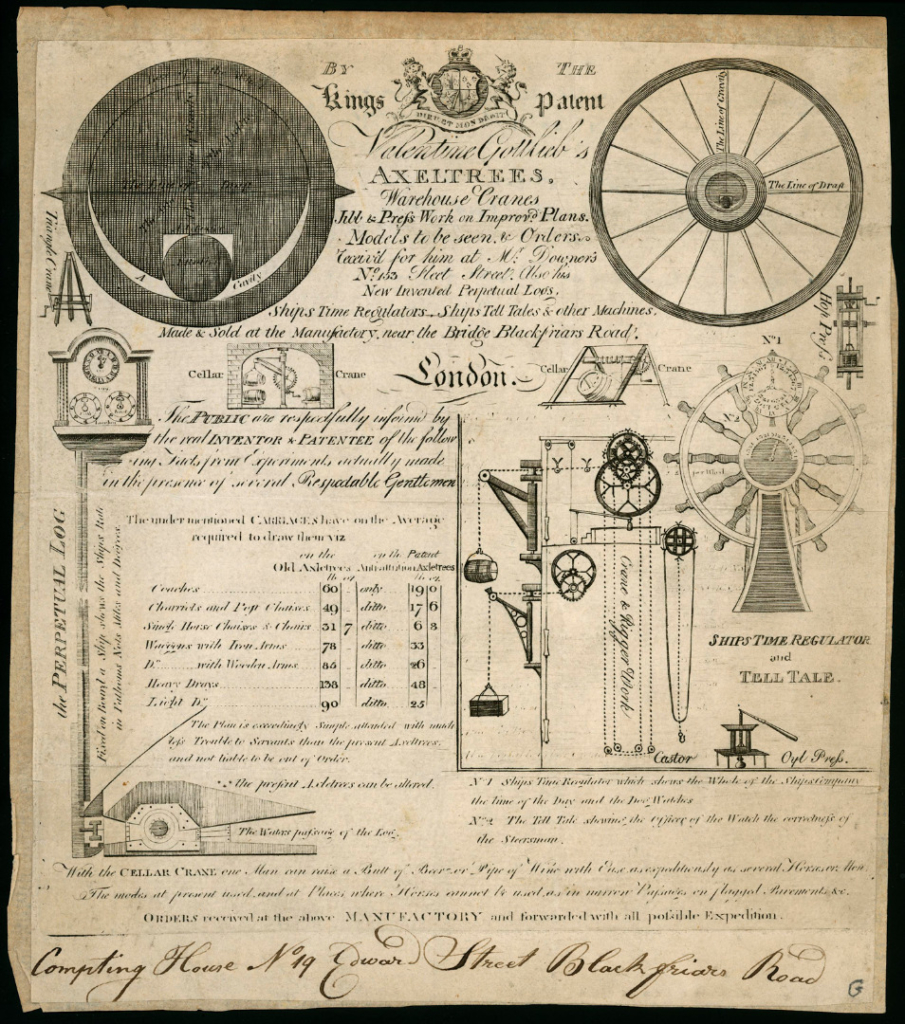
At the foot of the sheet is a contemporary inked addition: ‘Compting House No 19 Edward Street Blackfriars Road.’ On the reverse a twentieth century hand has added the note: ‘Valentine Gottlieb. Hairdresser & Perfumier, in the Parish of Saint Botolph, Aldgate. Two Patents. – 1577 9 Dec 1786 for Cranes. 1592 19 March 1787 Axletrees for Carriages.’ In 1813 he is described as ‘Engine & Machine Maker, New Cut. Lambeth’.
Henry Calvert’s 1971 catalogue Scientific Trade Cards in the Science Museum Collection integrates collections largely assembled between the two world wars, by two separate collectors of scientific instruments and related material, Thomas H Court and George H Gabb. Despite the title, Calvert did not produce a comprehensive catalogue of trade cards within the Science Museum collections of early instruments. It does not, for example, record the many that have survived pasted into the fitted boxes in which the instruments were sold. It also includes pieces that are only marginally related to scientific instrument making, and some items that are not trade cards at all.[1] This article has two separate purposes. Firstly it aims to unpack the evidence from a single trade card listed in Calvert’s catalogue. Secondly, in doing so it aims to demonstrate the potential value of careful study of this and similar ephemeral evidence. To locate, digitise, fully catalogue and put online the Science Museum’s rich collection of trade cards would permit intellectual access to a valuable and sometimes unique source for studies of trade and commerce. Interest in and awareness of the ephemeral literature of commerce has long moved on from antiquarian accumulation, as exemplified by Calvert’s basic listing of the Science Museum collection, through analysis of the graphic design by historians of art, to evidence requiring evaluation by historians of material culture.[2] Michael Crawforth demonstrated the usefulness and the pitfalls of using trade cards as evidence in tracing the history of the British scientific instrument trade (Crawforth, 1985). The accepted terminology is, as Maurice Rickards explicitly points out, ‘ambiguous’. The term embraces a single, usually small sheet of paper sometimes printed in letter press, and supplemented with a woodblock illustration – or more often the whole printed from an engraved copper plate, which offered greater opportunity for decoration and eye-catching imagery. The trade card recorded a business name, address and products. They were used from the late seventeenth century to serve as a memorandum sheet for a client, or as an invoice, a receipt or a quotation. Only later were they printed on card, and given to potential clients as an aide memoire. Like their paper forebears they could be pasted into boxes to record the seller, if not the actual maker of the associated item. They were also a form of advertising (Rickards, 2000). The Gottlieb piece in the Science Museum collection is certainly advertising. It is also in effect an illustrated catalogue of almost the whole range of products that he designed and could make, or have made, for prospective clients. It is an example of the grey literature which in recent decades has been recognised as a significant resource by archivists and librarians. This paper does not merely use it as an illustration, but uses it, in conjunction with sparse evidence, including newspaper advertising and encyclopedia entries to record the life and times of a hitherto largely unrecognised immigrant who established himself in London, c. 1775, becoming an engineer, designer and assembler of machinery.
Outline biography of Valentine Gottlieb
https://dx.doi.org/10.15180/211510/003John Vallientine [sic] Gottlieb was born at Biebrich, on the Rhine, in what is now the State of Hesse. He was one of a significant number of Germans immigrants who came to England to pursue business interests. He applied for and was granted naturalisation in 1776 (Parliamentary Archives, 1777).[3] At the same time, like many other German entrepreneurs who settled in London, he purchased Freedom of the City, further indicating that he was not without capital, nor unaware of the need to meet formal requirements.[4] That he wished to learn more of his adopted country may be presumed from his subscribing to a History of England, which appeared in weekly parts from late 1777.[5] A recent study implies that he was, at least initially, operating as a commodity broker (Beerbühl, 2007, p 228).
From 30 Camomile Street, in the City of London, giving his trade as hairdresser, he took out a Sun Insurance Fire Policy in October 1779, valuing his property at £200 (London Metropolitan Archives, 1936).[6] It is uncertain if this was a stop-gap occupation, but it indicates that he was his own master, and not working as an employee. In December 1786, as hairdresser of St Botolph’s Parish, Aldgate, Gottlieb registered a patent, on the design of cranes, filing the required specification the following January (British Patent 1577). He enrolled a second patent in the spring of 1787, with a detailed design of an axletree – that is the bearing on which a wheel of a carriage revolves – a design that claimed to reduce bearing friction. This time he gave his profession as perfumer (British Patent 1592). At this date, the registering of a patent was a time consuming and expensive procedure, costing between £100 and £120 (Harrison, 2006).
Gottlieb early appears to have come to an arrangement for the manufacture and sale of what was called the ‘anti-attrition axletree’. The factory in Chambers Street, Goodman’s Fields, was destroyed by fire, but a new location was opened in late 1791 at Curtain Road, Moorfields. An established coach-maker, with premises in the City of London, George Wellings of Camomile Street, Bishopsgate Street, installed them in his products (Observer, 1791).[7] Whilst initially he may have remained in the beauty business,[8] Gottlieb was inventing across a wider horizon – the December 1791 issue of a London monthly magazine published illustrations and descriptions of his design for a perpetual log, with an associated ship’s time regulator and a tell-tale showing the course (Gottlieb, 1791). There was a period of temporary financial embarrassment; in the summer of 1794 as an ‘engine-modeller and manufacturer of machineries’ he applied under the prevailing Act for the Relief of Insolvent Debtors for release from the King’s Bench Prison, indicating that he owed less than £200 (London Gazette, 1794).[9]
As ‘Anti-attrition Axletree and Nautical Machine Maker’ of Blackfriar’s Road, Valentine Gottlieb appears in a 1794 directory (Kent’s Directory of London and Westminster &c, 1794).[10] Subsequent directory entries describe him more generally as ‘engine and machine maker’; whilst press advertisements allow a closer plotting of his move from Thurlow Street, Pitt Street, Blackfriars Road (1801) to New Buildings, New Cut, Blackfriars Road (1808).[11] In his press advertisements Gottlieb indicates that he could be contacted each afternoon at Lloyds. It is unlikely that he made such regular visits solely for the purposes of meeting potential customers for his machines – perhaps he continued to operate as a broker.
In the early summer of 1818 Gottlieb advertised that he was selling the premises and business ‘which he is quitting from ill health’.[12] He had written his will in September 1815, from his home at Pear Tree Row in the New Cut, Lambeth. After requesting that his funeral should be ‘as plain as possible’, he indicated that ‘in consideration of the long and faithful services of Susannah Hills otherwise Hill for many years and now residing at my residence aforesaid she having received from me no salary or reward whatsoever’, he leaves her, without being specific, all his money in the funds, his freehold and copyhold estate, his personal estate, money, household furniture, plate, linen and all other effects. He also appointed her his sole executor. She proved the will in February 1821,[13] taking further steps to dispose of the business and its premises – the sale of 1818 not having found a buyer. An auction in June 1821 also failed to find a buyer. She presumably had more success in December 1822, for local antiquary Thomas Allen in his 1826 peregrination of Lambeth recorded:
In Lambeth Marsh resided Valentine Gottlieb, an ingenious mechanist and civil engineer. He was a native of Germany and died here the beginning of the year 1820. His residence was what is now Messrs. Edwards hat manufactory (Allen, 1826,; Tanswell, 1858).[14]
The iconography of the Gottlieb trade card
https://dx.doi.org/10.15180/211510/004Graphically the Gottlieb trade card follows an established convention of being headed by the Royal Arms, underlining the status of holding a patent of invention. Only the cognoscenti would know that English patents for invention were granted without any meaningful technical evaluation of the specification. The King will have formally passed the grant – but it did not reach him until the applicant had paid all the relevant fees to a succession of officials (MacLeod, 1988).
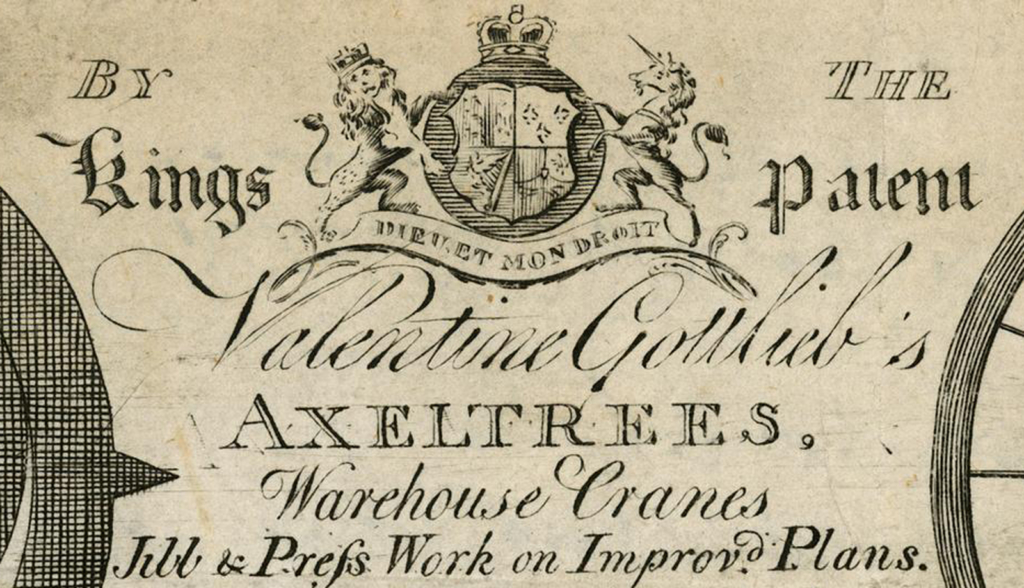
What distinguishes Gottlieb’s trade card from those of many contemporary cards is that it is devoid of baroque, rococo or neo-classical decoration through which many traders demonstrated their ‘good taste’. Beyond the royal arms, there is no use of stock imagery. There are eleven bespoke drawings providing visual evidence of the range of products unique to Gottlieb – items he had designed and would make or have manufactured, for his clients. They relate to the crane patent of 1786, the axletree patent of 1787, and the scientific instruments published in 1791, plus a hop press and a castor oil press. It is quite possible that the copper printing plate was added to over the years, squeezing in vignettes of a triangular crane and the two presses. It is also likely that some of the text was re-worked – notably within the two lines ‘Receiv’d for him at Mr. Downer’s | No: 153 Fleet Street…’: note that the upper case ‘R’ is truncated and the figure ‘153’ is cramped. Messrs Downer & Saunders, furnishing ironmongers, were at 153 Fleet Street from 1811 to 1814; by 1816 the firm was trading as Henry Downer, and at 155 Fleet Street.[15] That Gottlieb sold castor oil presses is first mentioned in an advertisement of 1810 (Public Ledger, 1810). That models of his various inventions could be seen at his counting house is noted in advertisements from 1808 to 1810 (Public Ledger, 1808, 1810).[16] Taken together this suggests that the Science Museum example is a pull from a re-working of the original plate, and dates from the last decade of Gottlieb’s business life.
In stylistic terms, Gottlieb’s trade card is similar in format to that issued by George Stratton, the ironmonger and manufacture of patent stoves and kitchen ranges.[17] Certainly from the mid 1790s Gottlieb’s designs were being marketed by the successor business of Stratton & Hills, later trading as Stratton & Co., and then as Stratton & Crowder, from their warehouse on Cheapside. They advertised Gottlieb’s patent anti-attrition axletrees, his perpetual logs and ship’s time regulators, his cranes and other machinery.[18] At the same time, when Gottlieb advertised his new hop press he also indicated that his portable cellar crane could be seen at work at the Stratton & Crowder manufactory on Blackfriars Road (The Times, 1796). Based on the south bank of the Thames, it would have been useful for Gottlieb to have an association with a business in the City. By the second half of the first decade of the nineteenth century, Gottlieb’s own advertising indicated that he ‘attends at Lloyd’s, generally from three till halfpast’ (Observer, 1806). Like George Stratton, Gottlieb’s card provides a handy visual catalogue of his designs, though it largely stands apart within the genre, for much of what he designed, and was wanting to sell, were products aimed at hard-headed industrial and commercial purchasers. In contrast trade cards were generally targeted at the domestic buyer, in a society where consumerism was becoming increasingly rampant (Styles, 1993; Glennie, 1995).
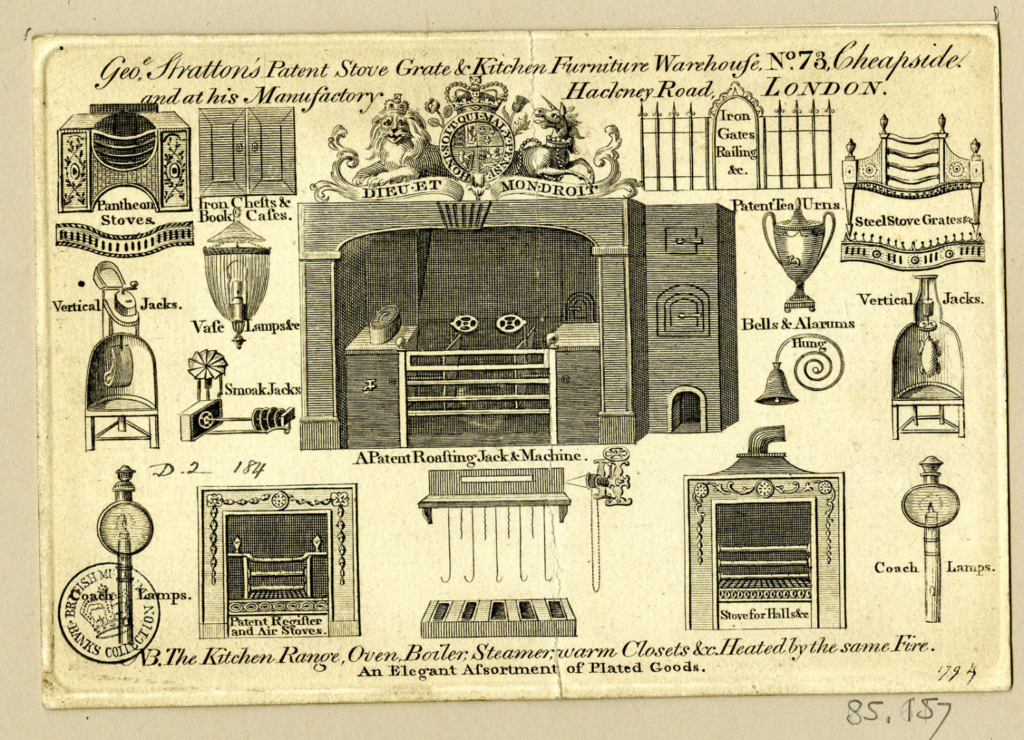
Gottlieb’s products: I: the anti-attrition axletree
https://dx.doi.org/10.15180/211510/005
It is a measure of Gottlieb’s own perception of the relative importance of his products that the trade card gives greatest visual prominence to the 1787 patent axletree, with images set on either side of the royal arms. To the left is a cross-section of the axle showing the bearing, to the right the bearing is shown set within a carriage wheel. Furthermore, Gottlieb has included a table providing an experimental quantification of the reduction in drawing power required when the anti-attrition axletrees are fitted. At the foot of the table carriage owners are assured that the design is ‘exceedingly Simple, attended with much less Trouble to Servants than the present Axeltrees, and not liable to be out of Order’. Furthermore they are informed that they would not need to invest in a new carriage as ‘the present Axletrees can be altered’.
The step from registering a patent to successful commercial exploitation was rarely straightforward. Press advertisements issued from 1788 to 1791 indicate that the ‘anti-attrition axletree’ was being manufactured at a factory at 12 Chamber Street, Goodman’s Fields. Following a disastrous fire in June 1791 manufacture moved to Curtain Road, Moorfields. The location is identified as ‘Mr. Sander’s patent axletree manufactory’, with 13 adjacent houses and a timber yard at the rear also engulfed. The damage was estimated at ‘near £30,000’.[19] It would be convenient to identify Sanders with the Sanders/Saunders who was subsequently in partnership with the furnishing ironmonger Henry Downer of Fleet Street, who is named on the trade card as Gottlieb’s city agent for taking orders.[20] It is noteworthy that Gottlieb’s name does not appear in any of these advertisements. The earliest copy does not even mention that the design is covered by a patent (The Times, 1788). A second refers to an un-named patentee as the maker (Public Advertiser, 1790). Another, after the fire, refers to the ‘Patentees’ (Observer, 1791, 1792). The presumption is that Gottlieb had taken a partner or partners to manufacture his designs. Implicitly the trade card reflects the fact that Gottlieb was now operating on his own behalf. This is explicitly emphasised in the heading to the table where ‘The PUBLIC are respectfully informed by the real INVENTOR & PATENTEE of the following Facts from Experiments…’
The axletree advertising copy included a table providing an experimental quantification of the reduction in drawing power required when the anti-attrition axletrees are fitted. There are some minor differences in the figures, and the table on the trade card is marginally expanded. The general nature of the experimental set-up is explained in the 1788 copy:
As there appears to be no way so certain to ascertain the strength or force required to draw a carriage, as by a weight over a pulley, the Proprietor begs leave to assure the Public that the following experiments have been made before several respectable Gentlemen…
There follows the table showing the weights required to draw five different forms of vehicles fitted with conventional axletrees, and that required when the same vehicles were fitted with the anti-attrition axletree. The lightest, a chaise drawn by a single horse, had the load reduced from 31.5 lbs to 6.5 lbs. The heaviest, a beer dray normally requiring 138 lbs, moved with just 48 lbs. Readers were left to draw their own conclusions from these figures, but the advertising appears to have had an impact. One London newspaper advised the proprietors of the recently introduced mail-coach services (1785) to ‘raise their front wheels to four feet with hoop fellies and [fit] anti attrition axletrees’ (The Times, 1788). Another noted: ‘The Coal Merchants are not averse to their wagons having hoop-felly wheels, and the infinite advantage of the anti-attrition axles, which save four horses in ten’ (Public Advertiser, 1790). In an open letter to a mail coach contractor and the patentee of the coach design adopted by the Post Office (1787) for their new service, an anonymous correspondent provided his own design proposals, including ‘the best invention of anti-attrition axles’ (Kentish Gazette, 1790).[21] An advertisement for the disposal of farming equipment in 1799 highlighted ‘a double breasted broad wheel wagon, with anti-attrition patent axletrees, particularly adapted for the carrying trade, as it has many times carried 6 tons and 3 quarters with 4 horses only’ (Ipswich Journal, 1799).
In terms of the readily accessible record, the compiler of the article ‘Mechanics’ in the 1797 edition of Encyclopædia Britannica, after describing four of Gottlieb’s crane patent designs, added:
The friction of the axle-trees of these machines may be considerably diminished, by applying an improved axle-tree invented by Mr. Gottlieb, which he calls the anti-attrition axle-tree, and for which he has a patent. It is formed from a steel-roller, from 4 to 6 inches long, turning within a groove cut in the iron part of the axle; and the advantages discovered by Mr. Gottlieb will be seen by the small table subjoined. A section of this axle-tree is represented in fig. 65 where a is the axle-tree, b the groove, c the roller, d the cavity between the lower part of the tree and the box c. In figs 66, 67, f represents the oil-vessel supplying it with oil, g the tube to convey the oil by, h the straps of ditto, i the fastening screws. Figs 63, 64 give a side view of the axle.
Advantages of the anti-attrition axle-tree.
Old Axle-tree Anti attrition
lb oz lb oz
Coaches 60 0 only 19 0
Chariots, post-chaises, &c 49 1 17 6
Single horse chaises and chairs 31 7 6 8
Waggons 78 0 33 0
Drays for beer 138 0 48 0
(Britannica, 1797, Vol 10, pp 748–8)
The Britannica table is very similar to that appearing in press advertisements in 1790 and 1791 (Public Advertiser, 1790; Observer, 1791). In contrast the illustration is quite distinct from the drawing that accompanied Gottlieb’s patent specification. Notably it is unrevealing about the variety of designs for roller and groove that the designer envisaged for a bearing with reduced friction.
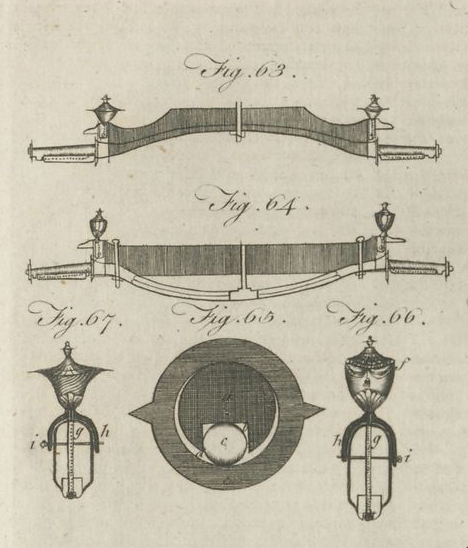
Furthermore the patent merely refers to an oil vessel used to lubricate the bearing during operation, and shows it symbolically as a crown. The Britannica article, however, illustrates the lubrication devices in some detail. This suggests that whoever wrote that entry had had direct communication with Gottlieb. It may have been an editorial decision not to detail the bearing design, but it is equally possible that the patentee considered it commercially inadvisable to reveal the full details of his design. The oiler would be familiar to all machine makers and users. Anyone wanting to read the patent could arrange to do so, for a fee – but it required visiting London or employing an agent to do so. In contrast Britannica would be more generally available, and Gottlieb cannot have been unaware that policing illicit use of his design would be difficult.
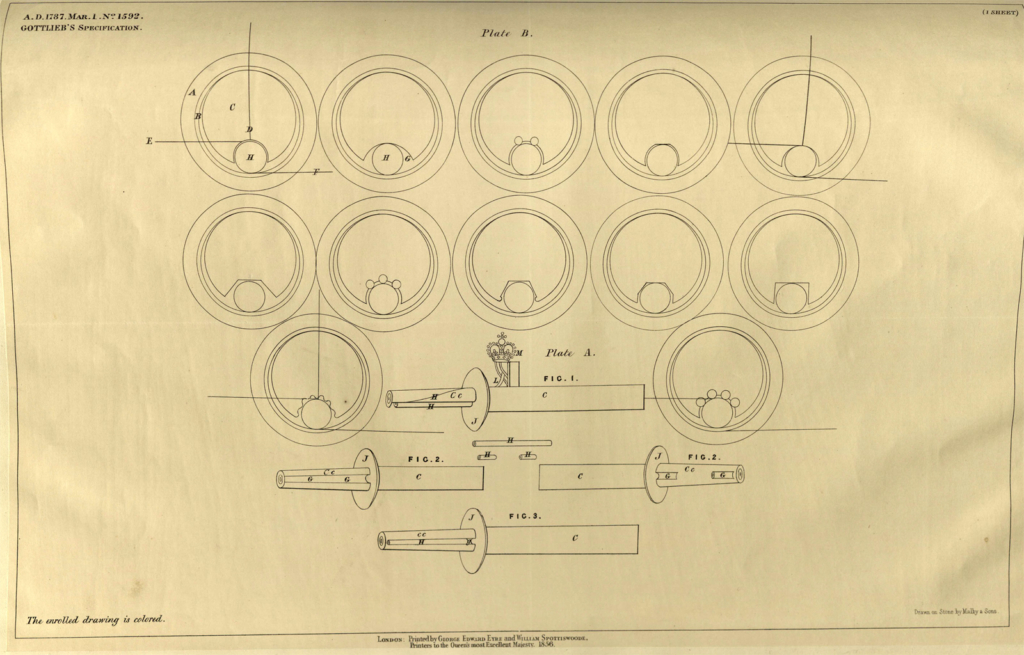
The Britannica text and illustration were given subsequent wider circulation by unacknowledged re-use by other compilers, printers and publishers (English Encyclopaedia, 1802; Encyclopaedia Perthensis, 1808; New and Complete American Encyclopaedia, 1811). In the next edition of Britannica (1810), the plate was retained, unchanged but the table was deleted from the text and the description considerably shortened with the addition of a critical comment that is based solely on consideration of the simple design illustrated in 1798:
When the wheel-carriages are at rest, Mr. Gottlieb has given the friction wheel its proper position, but it is evident that the point of greatest pressure will change when they are put in motion, and will be nearer the front of the carriage. This point, however, will vary with the weight of the load; but it is sufficiently obvious that the friction rollers should be at a little distance from the lowest part of the axle-tree (Britannica, 1810, Vol 13, p 110).[22]
The multi-volume part-published Cyclopaedia edited by Abraham Rees commissioned articles from experts in the field (Rees, 1802–20). This was in contrast to the widespread ‘cut and paste’ compilations often practised by other contemporary encyclopaedia editors. John Farey Jr (1791–1851) wrote much of the article ‘Wheel’ for Rees, which appeared in late May 1818. He included a section dealing with the axletrees for wheels of carriages, noting:
There are many sorts of axle-trees and boxes invented various ways, with a view of attaining the following advantages; viz. To contain a longer supply of grease or oil, to be more durable, to secure the wheels, and to lessen the draught.
As elsewhere in that article, Farey drew heavily on patent specifications. After describing the common form of axletree he detailed four specific designs, opening with the 1787 patent of John Garnett ‘the best kind…for some years manufactured in great numbers, but being very expensive, they fell into disuse, although very complete. This invention has been lately revived by Mr Panter’. Then follow three paragraphs on ‘The Patent Anti-Attrition Axle-tree and Box’, though Gottlieb is not named as patentee, designer or manufacturer – perhaps an indication that at the time Farey was writing the article Gottlieb’s business had become relatively inactive. The 1792 patent cylinder axletree and box of John Collinge was particularly lauded: ‘have been a considerable time in use, and their advantages have been proved in the length of time they wear, in the silent and steady motion they preserve to the wheels, in the advantage of retaining the oil to prosecute a journey of two thousand miles without being replenished; and lastly they are very durable, and but little subject to be out of order.’ Farey’s familiarity with such patents as a record of technical innovation is balanced by his awareness of contemporary commercial impact. He concluded, ‘There are many other patents for axle-trees to wheels; but as few of them have come into use, we shall only notice Messrs. Flight and Brook’s patent axles (Farey, 1818).[23] There were indeed many other patents for axletrees to wheels, the earliest dating to 1711, with 11 entered in the 1780s, four in the 1790s, eight in the next decade and 13 between 1810 and 1819.[24] Farey failed to mention the ball-bearing incorporated in the axletree designed by the Yorkshire agriculturalist Charles Varlo in the early 1770s, which was not patented, but briefly marketed in the North of England and Scotland on a subscription basis (Varlo, 1772).[25] Neither did Farey refer to the ball-bearing incorporated in 1794 of the patent axletree designed and manufactured by the Carmarthen iron founder Philip Vaughan (Vaughan, 1794).[26] Presumably neither design made an impact that lasted into the second decade of the nineteenth century. Both have been retrospectively recognised by recent practitioners as marking significant steps in the development of the modern ball-bearing, but these studies are based solely on surveys of the primary literature, and do not investigate the extent to which a design was manufactured or how it performed in practice (Dowson, 1976; Dowson and Hamrock, 1981). What is clear is that Gottlieb was entering a particularly competitive market, and one in which the greatest commercial impact appears to have been achieved by John Collinge.[27] Garnett’s patent bearing was primarily applied in machinery.[28] Though drawing much technical detail from specifications, Farey’s comments bear the hallmark of one whose trawl through the archival records was tempered by direct experience. The Collinge business utilised that patent design more widely than in carriage axletrees. The Gottlieb anti-attrition axletree design was equally applicable to more general application in machinery, as the patent specification itself indicates. The 1797 Britannica records that he intended to apply it to the crane designs of his second patent.
Gottlieb’s products II: cranes
https://dx.doi.org/10.15180/211510/006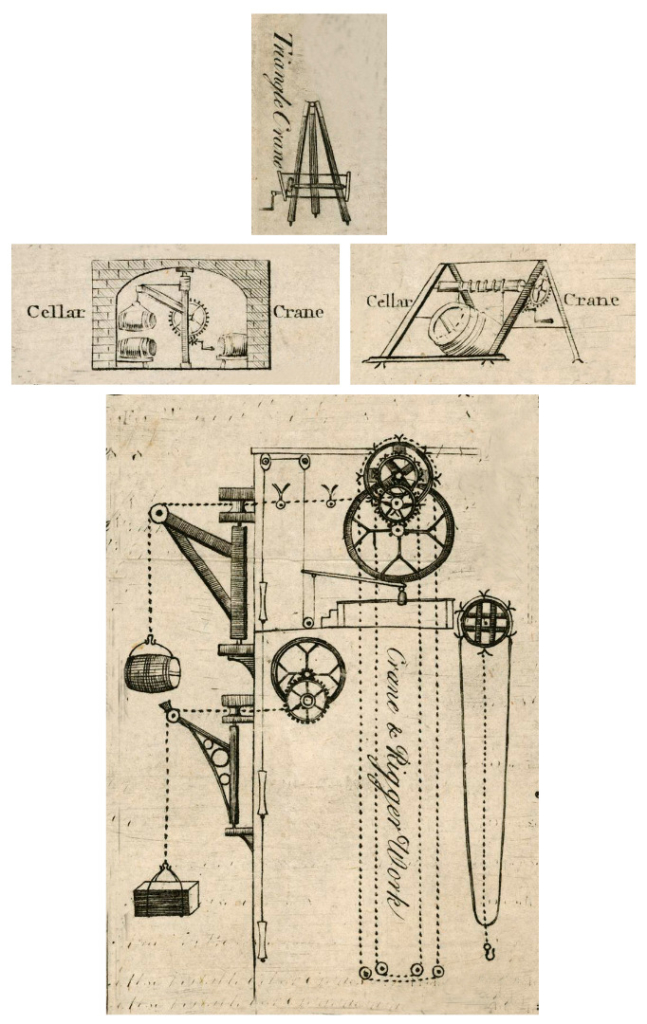
As noted in the previous section, an account of Gottlieb’s second patent appeared in Britannica as an aside to the description of four of his cranes within the extended entry ‘Mechanics’ – the cranes being the subject of his first patent. The illustrations made for Britannica complement the explanatory text and being larger are more technically informative than those on the trade card – the latter includes another form of cellar crane, plus a little drawing of a triangular crane.
The Britannica plate is not entirely a re-working of the drawings enrolled with the patent specification. The hoisting crane, the cellar crane and the carriage for moving very heavy weights, items 3–5 of the patent specification and Figures 61, 60 and 62 of the Britannica plate, are little more than re-drawn versions, though the latter is shown without the superstructure on which the heavy load would be placed. However, the warehouse crane (‘Fig. 59.’ in Figure 8, below) is quite different. It is said to be a drawing of lifting equipment installed at the Sugar House in Camden Town, London. The design allows the hand-crank on the first stage platform to be disconnected. A horse, harnessed at A, can be used to operate this and other mill work. Such a feature does not appear in the patent specification. This drawing must have been supplied by Gottlieb himself.
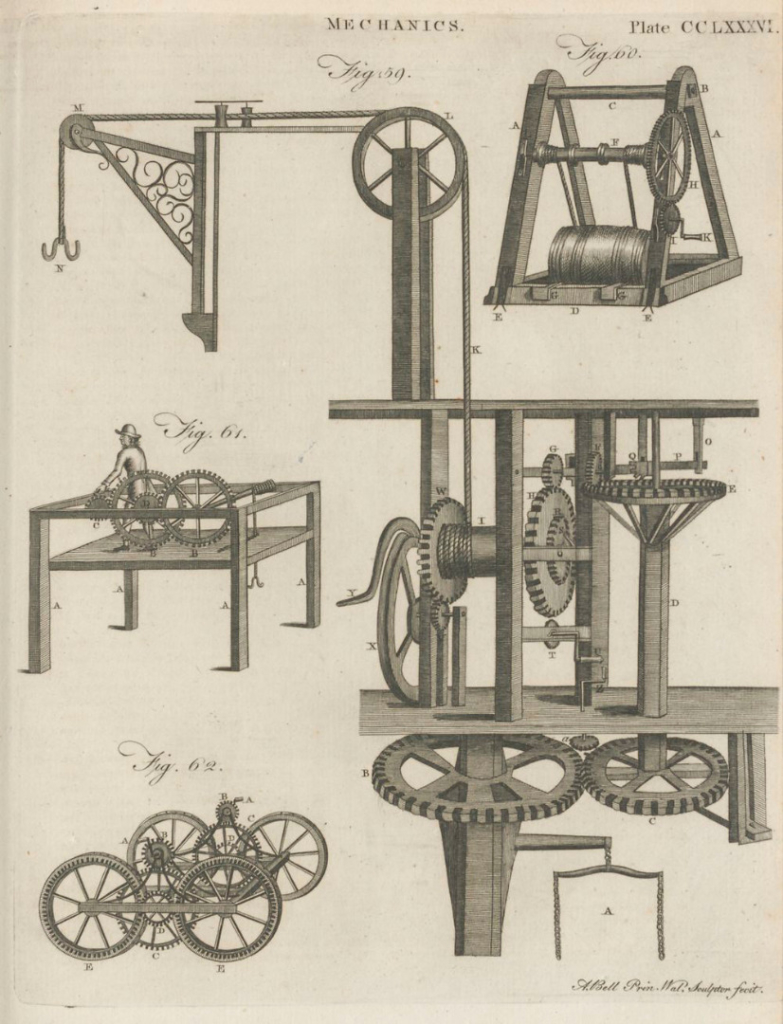
The Camden warehouse crane is in no way novel and is devoid of a key feature incorporated in the design of the two large warehouse cranes that open Gottlieb’s specification. This is the provision of two jibs, so that two loads could be independently raised or lowered – an idea that would have required some logistical finesse whether taking goods in or out of the warehouse. A more unusual feature is incorporated into the design of the first warehouse crane, and is highlighted in the brief description given by the patentee when lodging the initial application: ‘A crane of an entire new construction, in which by increasing the power, labor is diminished, and will perform its operations in a much more expeditious and less dangerous manner than any hitherto used’ [my italics].
This is an informative description of the intent of the patent, in contrast to the abrupt ‘Cranes’, supplied by Bennett Woodcroft when he undertook the massive re-organisation and retrospective numbering of patents for invention following the establishment of the Patent Office in 1852.[29] The detailed description of the wharf crane that opens the specification describes the inclusion of a 14 hundredweight (about 710Kg) counterweight that is enclosed within a pair of large diameter wheels, as in a treadmill crane. The oscillating movement of the ‘Burthen’ within these wheels is maintained by a complex system of ropes running round grooved pulleys. The purpose is to counterbalance the load, so that it does not run away when the operator cannot exert sufficient force on the winch. More or less en passant, Gottlieb states in the specification that this feature of the design protects operators from ‘the imminent danger to their lives or the loss of their limbs’. The design would add significant costs, in an era when labour was cheap and dispensable. In contrast, the Camden crane has the conventional and perfectly adequate spring-loaded pawl and ratchet to halt a runaway load, a feature that Gottlieb incorporates into the specification for his second warehouse crane.
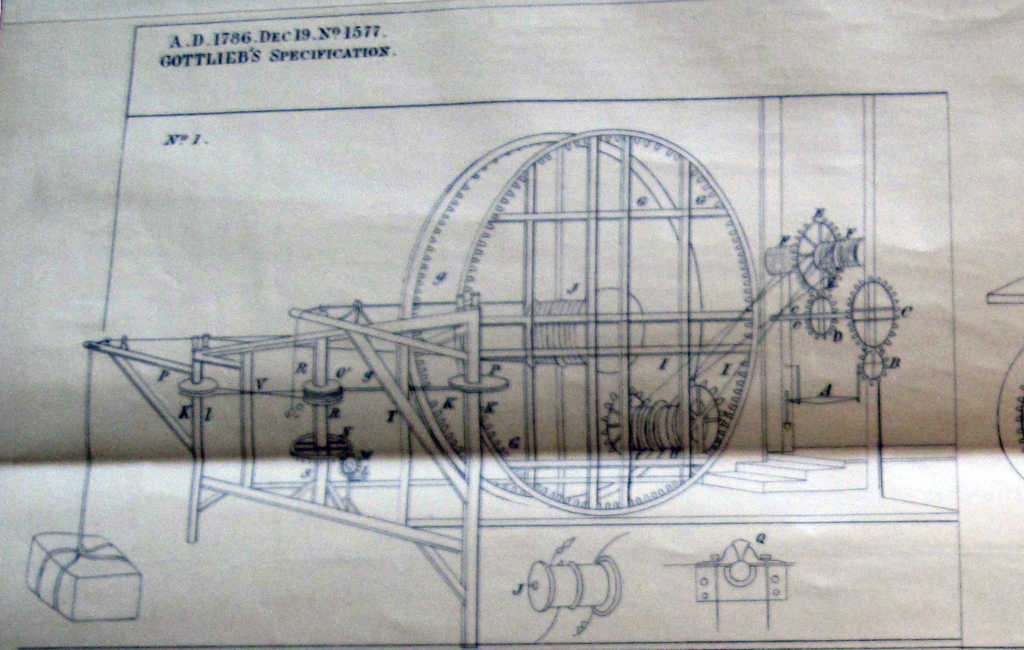
As noted in the previous section, the Britannica article was widely mined by other encyclopaedia compilers.[30] In contrast, the entry ‘Crane’ in Abraham Rees’ Cyclopaedia draws largely on contemporary printed sources, and in particular on the various crane designs awarded prizes by the Society of Arts. It seems probable that the author was the mineral surveyor John Farey Snr, or possibly his son John Farey Jr, who was already earning a living as a draughtsman specialising in technical illustration, and who drew this and other plates for Rees, as well as writing several entries – see previous section. Farey senior was a long standing member of the Society of Arts, and so father and son would have had ready access to the Transactions of the Society. The article includes two notable exceptions not taken from available literature. There is an illustration and detailed description of a large crane that had been operating at the wool quay of the Custom House in London since 1789, designed by the renowned engineer John Smeaton (1724–92). There is also a short description and drawings of a warehouse crane ‘by Mr Valentine Gottlieb of Lambeth Marsh, London’. This positive inclusion of a Gottlieb design places him in particularly illustrious company. The author drew attention to the ‘original’ design of Gottlieb’s jib (the horizontal beam H – and not the outer wall of the warehouse, misleadingly also labelled ‘H’). It is constrained by rollers k and l. By means of a rack and pinion the beam can be drawn into the warehouse to load/unload.[31]
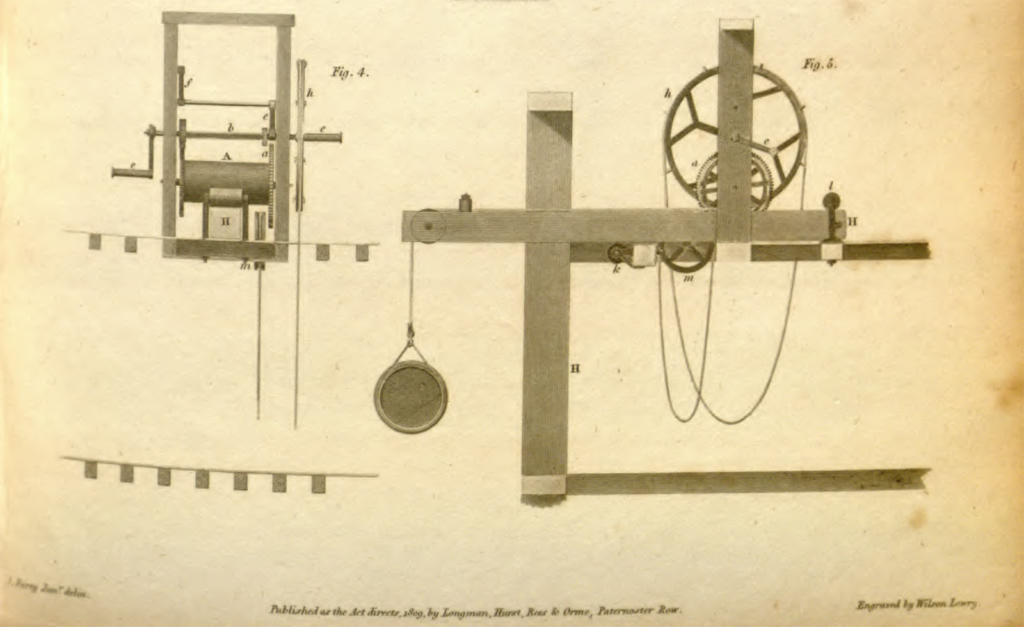
Beyond the 1797 Britannica statement that a Gottlieb crane was installed in Camden’s Sugar Warehouse, and Farey’s drawing and the associated description of the crane with the roller-mounted retractable jib, this author has been unable to find little evidence of market penetration. In 1810 Gottlieb himself advertised a pair of warehouse cranes that had been made for export to the Cape – but his client had left the country so the maker advertised them for sale. No price is mentioned, and the description is merely that they were ‘with two iron jibs, and all the iron work thereto, all ready for fixing with drawings and directions for fixing…with self howing [sic] gripes on a new principle’ (Morning Post [London], 1810).
Closer examination of the trade card suggests that the three small crane images may well have been added to the plate at a later date – for all three are crammed in, making the layout more busy. One of the cellar cranes is to the design in the patent and Figure 60 in the Britannica plate; the other cellar crane and the three-legged ‘Triangle Crane’ are additional designs, suggesting that Gottlieb had expanded his product range. Whether this was in response to the demands of clients, or in the hope of future sales, is presently a matter for conjecture.
Gottlieb’s products III: the perpetual log, etc.
https://dx.doi.org/10.15180/211510/007The December 1791 issue of the European Magazine contained an engraving plus explanatory text of this group of related navigational instruments – a perpetual log, time-regulator and tell tale (Gottlieb, 1791).
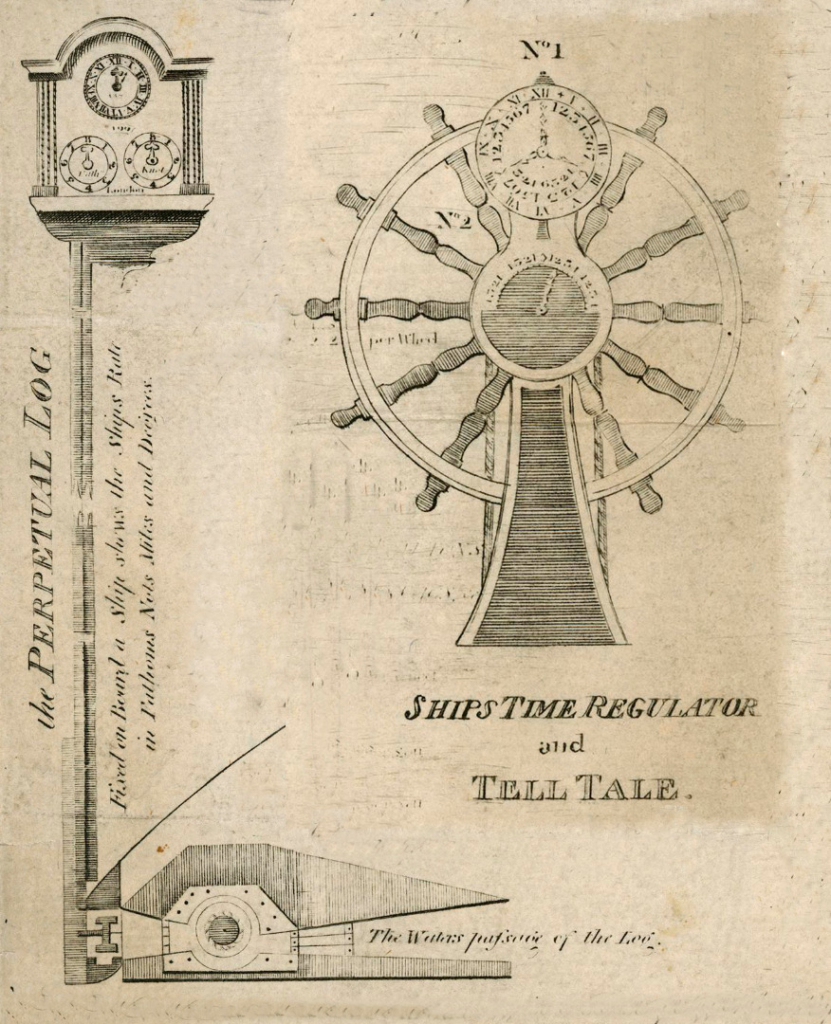
On the trade card the images are identical but separated, the perpetual log on the left and the ship’s time regulator and tell tale on the right. The latter two gadgets might well have generated interest in the 1820s and beyond when a growing number of the affluent took to yachting as a pleasure pursuit. The time regulator is a clock giving the time of day on the outer circle, with the related number of bells and the dog watches on the inner circles. The tell tale merely indicates the angle of the rudder, and thus if the helmsman is deviating from the set course. Neither of these devices would have had any use on either naval or merchant vessels. The perpetual log, in contrast, was an instrument of considerable interest to navigators. Despite the well appreciated inadequacies, conventional navigational practice largely retained dead reckoning to find a ship’s way. This meant regular heaving of the log to measure the ship’s speed and thus distance run. A perpetual log, especially one that provided an instantaneous onboard reading of speed, had long been considered a desiderata, and Gottlieb’s was one of at least two dozen such proposals made in England between 1714 and 1800, with over half made during the last two decades of the eighteenth century. Gottlieb’s awareness of the interest in a mechanism to measure the speed of a ship suggests he was in touch with current appreciation of the need to improve navigational practice.
The insertion of his design into the European Magazine needs a degree of explanation. The well-established Gentleman’s Magazine had from 1746 included occasional descriptions of novel scientific instruments (Delehar, 1993). This occasional practice was followed by the European Magazine founded in 1782, though like its elder rival the subject was dropped in the 1790s. Indeed, the Gottlieb instruments represent the final appearance of the topic (European Magazine, 1782; Bowles, 1783; an account of the making of artificial mineral waters, 1786).[32] That the editor should include this article is a reflection of his attempts to persuade a conservative naval establishment to improve the sailing performance of British ships by embracing technological change. In this context Gottlieb’s designs reappeared in the first volume of a Collection of Papers on Naval Architecture, associated with the recently founded, but short lived, Society for the Improvement of Naval Architecture. Having reproduced the earliest-known English account of a perpetual mechanical log (1722), which described what the device could do, but not how, the editor inserted ‘a MODERN INVENTION, where no security of Patent or other Mystery is used; but may be viewed, and its principles examined, or explained, by applying any day as directed’ (Sewell, 1791–3).[33]
At the foot of the associated text it is noted that the ‘Carteret and Westmoreland Packets’ had been fitted with ‘the above machine’. Carteret was launched in Deptford in December 1790, the first of an intended order of a dozen lightly-armed, swift boats commissioned by the government for the Post Office to convey mails between England, North America and the West Indies. Press reports indicate that she was ‘the first vessel that takes out the perpetual log invented by Mr Godlibbe [sic] which is so constructed as to ascertain the distance the ship runs in 24 hours’.[34] Gottlieb must have lobbied with some persistence to get his log fitted to Carteret and Westmoreland, and he used that status to lobby the Prime Minister in April 1794, making an unsuccessful case for a friend to be employed in the Excise Department.[35]
Gottlieb’s perpetual log, but not the trivial time regulator or the related tell tale, was illustrated and described in the 1797 Britannica. The entry supplements the text printed in The European Magazine, but could readily have been deduced from an intelligent reading of the drawing.
Nevertheless, it is a measure of Gottlieb’s appreciation of the importance of positive publicity that he managed to get descriptions of his patented cranes and axletrees, plus his perpetual log into the Edinburgh-edited and printed Britannica. What may be significant is that the log entry only refers to the log having been fitted to Carteret and Westmoreland – as cited in the original European Magazine article. This may imply that the initial two installations were insufficiently successful to ensure that they were fitted to the rest of the fleet. Certainly, when he later listed his ‘new invented Perpetual Logs, Ships’ Time Regulators, Ships’ Tell-tales’ among his products (Public Ledger, 1808), Gottlieb does not refer to them as being used by the Post Office packets.
The Gottlieb perpetual log is referred to in early nineteenth century surveys of mechanical logs, but there are no indications that the design had been proved successful and routinely used.[36] The Britannica entry was silently mined and repeated by others, though both later editions of Britannica and other encyclopaedists deleted the reference to the fitting of the instrument to Carteret and Westmoreland (Britannica, 1810, Vol 12, p 63).[37] It is indicative of the lack of acceptance by navigators of the various English designs of mechanical logs that appeared during Gottlieb’s business lifetime that, with the exception of the Russell and Foxon designs of the early 1770s, none are mentioned in Abraham Rees’ Cyclopaedia – the one multi-volume compilation where the authors of technical articles were more influenced by contemporary custom and practice, under an editor who eschewed compilations indiscriminately pulled together from readily available literature.[38] Like other contemporary designers of perpetual logs, Gottlieb may well have considered that a conservative naval establishment had misjudged his proposal. In any event, to have redacted the design from the copper plate used to print his trade card would have been a major undertaking.
Gottlieb’s products IV: other machines
https://dx.doi.org/10.15180/211510/008
What is apparent from Gottlieb’s advertising is that he was in the business of designing and supplying a wide range of machinery. The trade card illustrates small vignettes of a ‘Hop Press’ and a ‘Castor Oyl Press’. A hop press is first advertised in 1796 (The Times, 1796). Early in the next century it was advertised amongst a wider range of machinery as an adjunct to copy extolling an invalid bed, a prototype having been made for the King’s youngest child, the Princess Amelia, a delicate teenager who died in her late twenties. Potential purchasers could examine a working model at Gottlieb’s premises, or he would demonstrate it on demand at a client’s home, charging 10s.6d. for a visit within a mile of the Royal Exchange, plus 5s. for each additional mile (Observer, 1801).[39] Subsequent advertising concentrated on machinery. In 1806 ‘A new invention’ for cleaning cotton, soon called a ‘Cotton Jenning Machine’, and a ‘much improved Cotton Baleing Machine’ were first advertised. The latter offered ‘a great saving’ in freight costs, able to ‘pack 3 cwt. in 2 feet 6 inches, and 12 bales in a day’ (Public Ledger, 1806; Observer, 1806; Morning Post, 1806; Public Ledger, 1811). The Jenning machine could be powered by ‘any kind of mill work, and cannot be put out of order’. Furthermore it could also be worked by ‘children or old people, blind or cripples…and by advice received from the West Indies, a great number of Negroes are saved’. This was a year before Parliament abolished the Slave Trade, but it was a further quarter of a century before the institution of slavery was abolished across the British Empire. In ‘saving’ slaves, Gottlieb was hardly making a moral judgement in support for the abolitionist cause. He maintained that his machine could be operated effectively by unskilled labour that was otherwise a drain on the economy. It was his contacts in the West Indies, whose estates relied on slave labour, who reported that ‘a great number of Negroes are saved’ – with the implication that plantation owners could redeploy them in more productive activities. A coffee [bean] cleaning machine appeared in 1808 (Public Ledger, 1808), and in 1810 ‘Sawmills on a new and perfect construction…which will cut three sticks of timber each in 16 cuts; and one for the cutting of staves’ (Public Ledger, 1810). Most of Gottlieb’s advertisements indicated the full range of his products and invited any ‘planter, merchant, or captain of a Ship’ to visit and examine working models of his various designs – an indication that he made to order, and that his manufactory did not hold a stock of completed machines which potential clients could see (Public Ledger, 1810).
The end of the Gottlieb business
https://dx.doi.org/10.15180/211510/009With continental Europe a theatre of war, Gottlieb was aiming to expand his market by exporting machinery to the British colonies. His anti-attrition axletree faced and had been out performed by the patented design of John Collinge, whose wider business activities may well have stimulated Gottlieb to look to overseas markets. Collinge’s design for a mill to crush sugar cane had been well received and endorsed in 1796 by a general meeting held in London of the ‘planters, merchants and others interested in the British West Indian Islands…the improvement it contains to diminish friction, will require less power to work it, and from the simplicity of its construction, accurate workmanship, and durability, is greatly superior to the Mills now in use’ (The Times, 1796). The design, which incorporated the Collinge patent bearing, was certainly successful – his other key features were the use of iron (so that the equipment was less likely to be damaged in the event of fire) and the introduction of horizontal rather than vertical rollers (Porter, 1921; Deerr, 1921; Galloway, 1989). In his advertisements, Collinge was able to cite the performance of specific sugar mills in Jamaica and Antigua, and indicate that potential clients could see letters of approbation from other mill owners (Morning Post, 1804). Gottlieb merely asserted of his cotton baling machine, that ‘he has already sent, and does send, a great many to the different parts in the West-Indies’ (Public Ledger, 1810).
In September 1815 Valentine Gottlieb made out his will. In June 1818 the business premises, with the associated technical assets also available, were put up for auction, their owner ‘quitting from ill health’:
Roomy Copyhold Premises, centrally situated nearly adjoining the Waterloo-bridge-road, and opposite the New Cobourg Theatre, Lambeth-Marsh. – By Mr COOPER, AT GARRAWAY’s, on MONDAY the 25th inst. at Twelve, unless previously disposed of. THOSE capital PREMISES of Mr. Gottlieb, engineer, recently built in the most substantial manner, and occupying a large plot of ground, with an extensive frontage, in the above commanding situation; they are adequate for any manufactory requiring space and show, and particularly suited for a continuance of the present line, in which Mr. Gottlieb has been for many years successfully established, and which he is quitting from ill-health, and will do his utmost to further the views of a successor, who may be accommodated with his valuable models, tools, &c.; or convertible to an hotel, for which the situation is eligible. May be viewed, and particular had on the premises; at Garraway’s; and of W. M. Cooper. Blackman-street (The Times, 1818).[40]
There were no takers. Susannah Hills, Gottlieb’s live-in housekeeper, executor and sole beneficiary of his estate, did not find it easy to dispose of either the premises or the business assets. It was advertised heavily in the spring and early summer of 1821, and finally in late 1822 (The Times, 1821; Public Ledger, 1821).[41] When Gottlieb needed to step back from business, he did not have a reliable managing foreman to whom he could delegate the day to day running of the concern. Subsequently his executrix had little choice but to sell-up. It was probably valid for the auctioneer to claim that the site was ‘suitable to Engineers, Mechanics and others…and adapted to the present business’. It might well have been suitable for ‘a coach-maker, smith, corn-chandler, &c.,’ or even, as suggested in 1818, developed as a hotel. However, with a frontage of 36 feet and a depth of 72 feet, it was hardly an ‘extensive’ site (Public Ledger, 1822). The implication is that Gottlieb was designing, commissioning then buying-in cast and machined parts, which he may have trial-assembled on his own site, prior to erection on the client’s premises. The 1821 claim that the business was ‘rapidly increasing’ (The Times, 1821) can be no more than advertising hype.
Conclusion
https://dx.doi.org/10.15180/211510/010Tracing the fortunes of a relatively minor designer and manufacturer through his trade card, the press advertisements and encyclopaedia entries creates a window into the world of engineering design, technology and commerce in the late eighteenth and early nineteenth centuries. The sources themselves can be interrogated, but what is revealed needs to be treated cautiously. It is unlikely, for example, that the 1797 Britannica entries on the Gottlieb anti-attrition bearing, the crane designs and the perpetual log were the result of independent engineering assessments of their contemporary worth. Edited and printed in Edinburgh, the publisher was anxious to include new and up-to-date copy. He may well have responded positively to information provided gratuitously by the patentee. The re-use of text and illustrations in later encyclopedic works does not imply continued and positive contemporary awareness of their worth – it is more often a reflection of lazy editorial practice. Nevertheless, Gottlieb’s success in ensuring that his designs were brought to the notice of a wider public went beyond mere literary impact. John Farey’s 1808 description and illustration of a particular warehouse crane indicates that the originality and practicability of that realised design was appreciated by an observant commentator, a choice that bracketed the German immigrant together with the father of British civil engineering, John Smeaton.
Valentine Gottlieb had early appreciated the potential of publicity to promote his business products and no doubt he would have distributed copies of his trade card to potential clients that he contacted on his daily afternoon visits to Lloyds. That Gottlieb was able to get his perpetual log fitted to the first two newly-designed fast packets for the Post Office overseas mail service indicates particularly effective lobbying in a field where conservatism was prevalent.[42] His other apparently original designs – the anti-attrition axletree, warehouse cranes, invalid bed, machines for baling, cleaning cotton and coffee beans, and cutting fencing staves – were advertised in the London press from 1796. However, with the exception of the Camden warehouse crane, none appear to have been commented on by contemporaries. Presumably Gottlieb had an order-book that was sufficient to maintain the business. His will implies that in addition to the relatively small manufactory site, which was on copyhold from the Manor of Lambeth, he held other freehold and leasehold property. Taken together, and despite a short period of imprisonment for debt in 1794, he does not appear to have been short of capital. It is concluded that he was primarily an inventive designer, making commissions to order, specifying and buying-in many of the necessary parts from local foundries and wholesale ironmongers as and when required.
Biebrich born John Vallientine Gottlieb emigrated to London, naturalised and moved from operating in the service trade of hairdressing and perfumery into designing and commissioning goods largely for industrial use. The metropolis provided not only a vast reservoir of skilled workshops from whom parts could be ordered, but also a growing market. Taking business partners will have eased his way into the commercial sector. At the same time, and despite the ongoing conflict between Britain and France, the strength of the Royal Navy was able to negate the impact of Napoleon’s ‘continental system’ banning trade with Britain. Mastery of the sea allowed colonial trade to continue and London to flourish as an entrepôt. His machinery may not have been exportable to continental Europe, but it could be shipped to the West Indies and beyond.
The year 1811 is the latest date found for Gottlieb advertising in the London press. If that meant that his order-book remained so full that he did not need to draw attention to his ability to design and manufacture, then it should have been relatively easy to have found a buyer for a thriving business. The contrast with his close contemporary John Collinge is revealing. The latter protected both his axletree and sugar mill designs with additional patents, and added another product line, with a patent spherical hinge, and associated door and gate closers (Collinge, 1811, 1819, 1821, 1825). Collinge kept his name in front of the public through advertising, but he supported his claims through reference to specific installations. In a 1798 advertisement for his patent axletrees he named five members of the Royal Family who had had installed them on their carriages, together with the names of three dukes, five marquises, 12 earls and 21 lords – plus ‘upwards of 700 [un-named] private Gentlemen’ (The Times, 1798). Similarly, in 1804 he was able not merely to repeat the motion of approbation passed at a May 1796 meeting of planters and merchants with interests in the West Indies, praising his radically improved design for a sugar mill, but also to name Thomas Hibbert’s sugar mill at Orange Hill, Jamaica, which now ‘makes from sixteen to eighteen hogsheads of Sugar per week (on average) of eighteen to twenty hundred weight each, with the power of eight mules only’. Likewise he drew attention to a windmill on Christopher Coddrington’s Antigua estate, ‘which previous to the improved mill-work being applied, always yielded in performance to another wind-mill on the same set of works, but which has since had considerable superiority, and so little had been the friction of the gudgeons, blocks and cappooses, that when taken down for inspection, they did not appear to have been in use, and the oil that supplied them had not even changed its natural colour’(Morning Post, 1804). In advertising that appeared frequently from late 1815 he referred to the labour saving implications of his machinery for planters in the West Indies. As with Gottlieb, there may be a degree of ambivalence in copy aimed at estate owners based in London (London Courier & Evening Gazette, 1815; Morning Chronicle, 1815; Morning Post, 1815).[43]
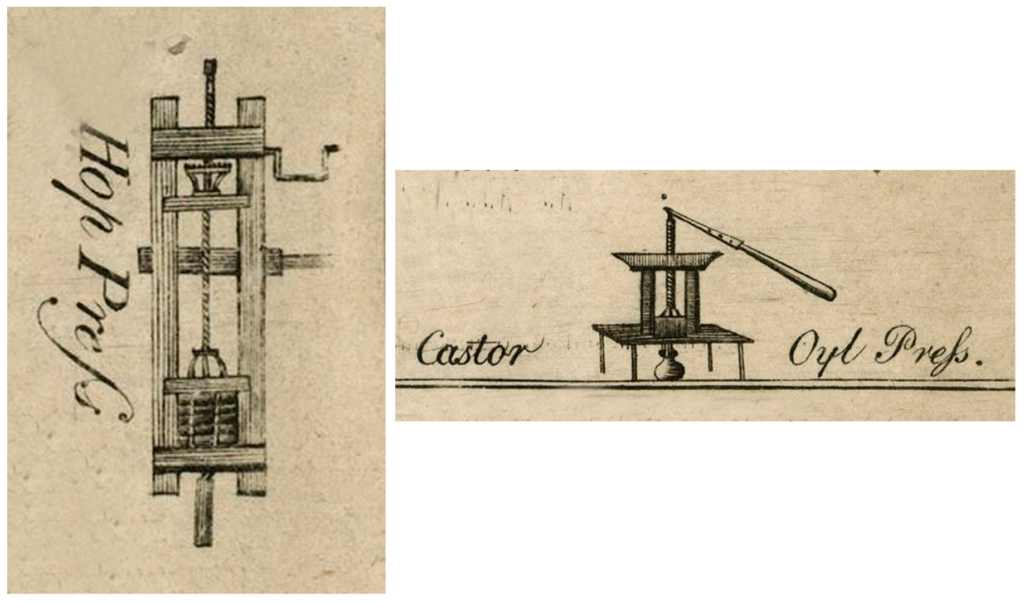
It might reflect a more enlightened and humane attitude towards labour forcibly imported from Africa and retained with minimal consent. Equally Collinge may be indicating to the London-based plantation owners who are his potential clients awareness that worn-out labour can no longer be replaced with new slaves. An investment in his machinery would facilitate keeping that finite resource working longer.[44]
Collinge’s son, Charles, was an early member, and office holder in the Institution of Civil Engineers. He continued the business on his father’s death in 1836. Despite the son’s early death (1841/2) (Minutes of Proceedings of the Institution of Civil Engineers, 1843), the company continued to prosper. Charles Collinge & Co. exhibited at the Great Exhibition of 1851 (Great Exhibition, 1851). They traded as suppliers of architectural hardware just into the first decade of the present century (London Gazette, 2011).[45] In stark contrast, the Gottlieb business faded with the health of its founder. Gottlieb’s trade card in the Science Museum collection appears to be the sole material survival of an enterprise begun by an immigrant entrepreneur who turned from hair-dressing to mechanical engineering. Lacking management succession, the business died with its creator.
Tags
Footnotes
For the Collinge patent see Collinge, J, 1787, ‘New invention and improvements in and upon carriage and other wheel boxes and axletrees’, British Patent 1626; and 1792, ‘New invention and improvements in and upon carriage and other wheel boxes and axletrees’, British Patent 1899.
For the Flight & Brook patent see: Flight, B, 1809, ‘Metal axle and box for wheeled carriages’, British Patent 3266, and Spratley, W, 1813, ‘Axle-trees of wheels for carriages’, British Patent 3770; also Spratley Brooks & Co.’s advertisement in Morning Chronicle [London] 4 i 1814. Back to text

